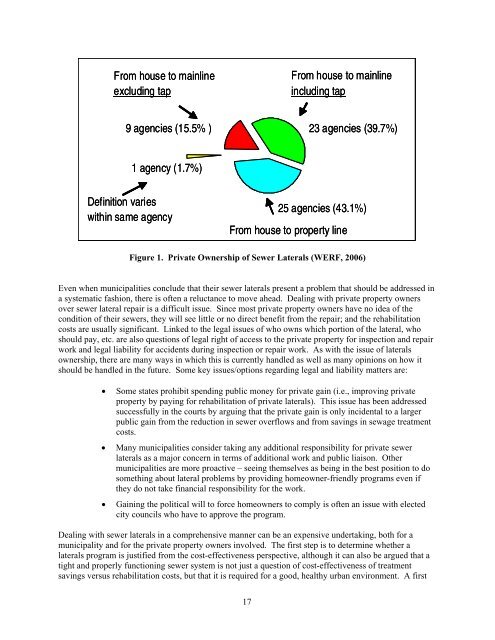Rehabilitation of Wastewater Collection and Water Distribution ...
Rehabilitation of Wastewater Collection and Water Distribution ...
Rehabilitation of Wastewater Collection and Water Distribution ...
Create successful ePaper yourself
Turn your PDF publications into a flip-book with our unique Google optimized e-Paper software.
From house to mainline<br />
excluding tap<br />
9 agencies (15.5% )<br />
1 agency (1.7%)<br />
Definition varies<br />
within same agency<br />
From house to mainline<br />
including tap<br />
23 agencies (39.7%)<br />
25 agencies (43.1%)<br />
From house to property line<br />
Figure 1. Private Ownership <strong>of</strong> Sewer Laterals (WERF, 2006)<br />
Even when municipalities conclude that their sewer laterals present a problem that should be addressed in<br />
a systematic fashion, there is <strong>of</strong>ten a reluctance to move ahead. Dealing with private property owners<br />
over sewer lateral repair is a difficult issue. Since most private property owners have no idea <strong>of</strong> the<br />
condition <strong>of</strong> their sewers, they will see little or no direct benefit from the repair; <strong>and</strong> the rehabilitation<br />
costs are usually significant. Linked to the legal issues <strong>of</strong> who owns which portion <strong>of</strong> the lateral, who<br />
should pay, etc. are also questions <strong>of</strong> legal right <strong>of</strong> access to the private property for inspection <strong>and</strong> repair<br />
work <strong>and</strong> legal liability for accidents during inspection or repair work. As with the issue <strong>of</strong> laterals<br />
ownership, there are many ways in which this is currently h<strong>and</strong>led as well as many opinions on how it<br />
should be h<strong>and</strong>led in the future. Some key issues/options regarding legal <strong>and</strong> liability matters are:<br />
• Some states prohibit spending public money for private gain (i.e., improving private<br />
property by paying for rehabilitation <strong>of</strong> private laterals). This issue has been addressed<br />
successfully in the courts by arguing that the private gain is only incidental to a larger<br />
public gain from the reduction in sewer overflows <strong>and</strong> from savings in sewage treatment<br />
costs.<br />
• Many municipalities consider taking any additional responsibility for private sewer<br />
laterals as a major concern in terms <strong>of</strong> additional work <strong>and</strong> public liaison. Other<br />
municipalities are more proactive – seeing themselves as being in the best position to do<br />
something about lateral problems by providing homeowner-friendly programs even if<br />
they do not take financial responsibility for the work.<br />
• Gaining the political will to force homeowners to comply is <strong>of</strong>ten an issue with elected<br />
city councils who have to approve the program.<br />
Dealing with sewer laterals in a comprehensive manner can be an expensive undertaking, both for a<br />
municipality <strong>and</strong> for the private property owners involved. The first step is to determine whether a<br />
laterals program is justified from the cost-effectiveness perspective, although it can also be argued that a<br />
tight <strong>and</strong> properly functioning sewer system is not just a question <strong>of</strong> cost-effectiveness <strong>of</strong> treatment<br />
savings versus rehabilitation costs, but that it is required for a good, healthy urban environment. A first<br />
17















